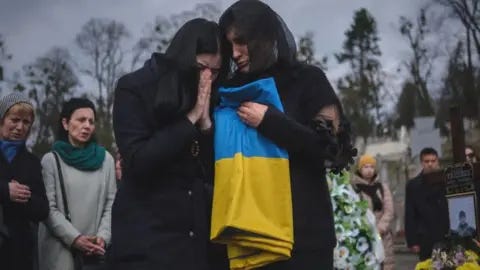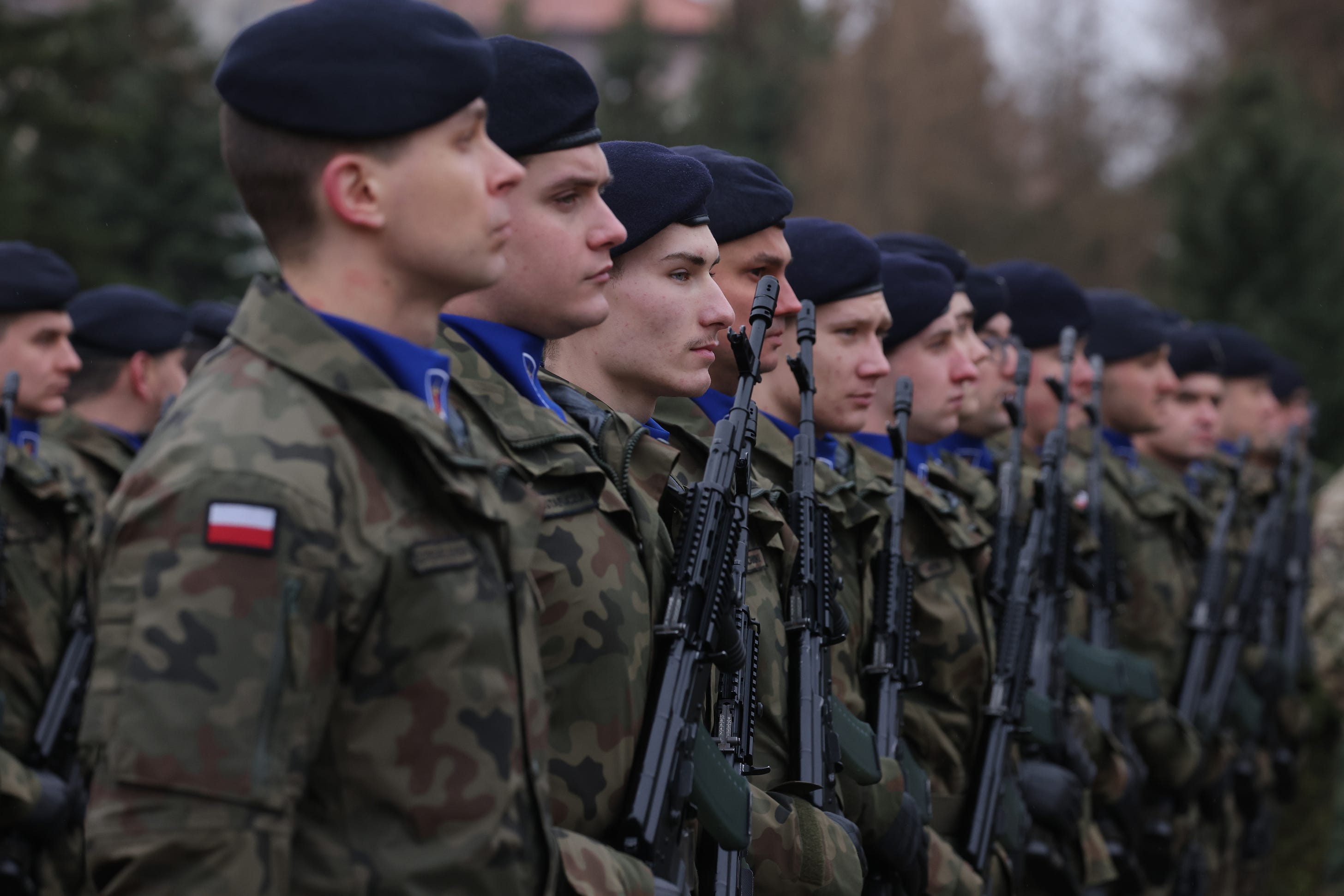Two-and-a-half years ago, Russia began a full-scale invasion of Ukraine, setting off the largest war the world has seen since 1945.
Although Russia's leaders have offered various spurious justifications for their illegal war of aggression, Vladimir Putin's nost consistent explanation has been ideological: Russia is an ancient state, and Ukraine is historically Russian land.
Let us take advantage of this half-anniversary to consider this claim.
Anniversaries take hold of the imagination, especially the round ones. The fullness of years and the beauty of numbers seduce us into myths of eternity and goodness. But history, unlike legend, is composed of fragments, of bits, of things we understand halfway, and seek to grasp ever better.
This is one reason why few historians grapple with the gilded myths that Putin has put forward about the ancient past, most notoriously in a long essay in 2021 and then in a tedious interview with Tucker Carlson in 2024 (both linked below).
When confronted with magical thinking by dictators, historians feel out of place, like a bridge player invited to judge prestidigitation, say, or a surgeon hired to care for wax figures.
Putin is in love with a legend. Historically speaking, this is very familiar: new regimes, such as Putin's, seek compensation in myths of ancient origin.
Putin's idea of Russia, his justification for the killing of hundreds of thousands of people, his rationalization of his attempt to destroy Ukraine as a people — it all rests on a very familiar sort of tall tale: we were here first. These stories are generally complete falsehoods, from the “we” through the “were” and the “here” and the “first.” And so it is for Putin.
But the stories get repeated so often that they take on a kind of leaden plausibility, like a bad habit. It takes a little work to throw them off. So here goes!
The legend begins with a single obscure incident, understood by Putin to prove the existence and endurance of a Russian state: Long ago there was a city called Novgorod, inhabited by people who were unable to get along. These quarrelsome folk, the Slavs, invited three Viking brothers, known as the Rus, to come and rule them. The arrival of Vikings began an unbroken tradition of a Russian "centralized state."
As he says, Putin has the story from a medieval chronicle, "The Tale of Bygone Years," probably from the early twelfth century. The monk (or monks) in Kyiv who compiled this text had heard about the arrival of the Vikings known as the Rus from Scandinavia, which had taken place about four hundred years earlier. In the intervening centuries, the various parts of the fractious Scandinavian clans had founded, taken over, and lost control of a number or towns in eastern Europe. The monk or monks knew were trying to explain why the Kyivan part of a Scandinavian ruling clan still known by the name Rus was more important than other clans in other places.
"The Tale of Bygone Years" is one of dozens of helpful medieval sources which touch on the Scandinavians in eastern Europe, which mix fable and useful information. These texts have to be read critically and together, and alongside the findings of archeologists and numismatists who have worked in the places in question. In what follows I will be doing this.
Before analyzing the legend that Putin loves, it would be helpful to spell out all of the claims it contains and that he draws from it, some of which are explicit, and some of which are implicit -- things that the listener might go away from the story believing, even though they are never stated.
1. There was a city called Novgorod when the Vikings known as the Rus arrived.
2. There were three Viking brothers.
3. The Vikings accepted the invitation and peacefully and durably ruled.
4. The people of this city were in some sense Russians because they were Slavs.
5. These Vikings were also in some sense Russians, since they called themselves “Rus.”
6. The existence of an ethnic group in a town more than a thousand years ago means a right to rule today by a dictator who calls himself a name that he also associates with that ethnic group.
7. The existence of the rulers of that ethnic group more than a thousand years ago means a right to rule today by a dictator who calls himself a name that he also associates with those rulers.
8. Events in one location more than a thousand years ago justify the existence and actions of a transcontinental empire engaged in a war of aggression against a neighboring state.
9. An algorithm exists whereby we can justify repression and war today via obscure, distant events.
10. This algorithm is known to dictators who tell the story, carry out the repressions and start the wars.
When spelled out like this, the claims reveal their magical character. Even if claims 1-5 were completely correct, the moral and political interpretations Putin offers in claims 6-10 are illogical and repugnant.
Such “reasoning” is why few historians will engage Putin's legend directly. It has nothing to do with history -- with assembling evidence, with questioning hypothesis, with making reasonable arguments based upon sources and traditions of interpretation. It is a claim to power, whose only sense arises from the power itself. That is really all that needs to be said.
Having understood that, historians can choose to go the extra mile, and note that the factual claims (1-5) are balderdash. It only really makes sense to do this in a constructive rather than in a destructive spirit, in an effort to reveal something about what we actually do know about early medieval Scandinavia and eastern Europe, and how we know it. It is in that spirit that I will proceed. Let us consider each claim in turn.
1. There was a city called Novgorod when the Vikings known as the Rus arrived.
There was not. Novgorod had not yet been founded at the time of the arrival of the Rus in the territories that are now northeastern Russia. It was founded about a quarter millenium later. (It had also not yet been founded when Vikings first began to lay claim to Kyiv, which already existed and was probably controlled by Khazars.)
Novgorod is attractive for a Russian myth because it exists now and it existed at the time the monks were writing. But it did not exist at the time of the events the monks were recounting. But this is just the very beginning of the profound untruthfulness of the story.
Here is what we know. Traders from Scandinavia were present around the body of water we now call Lake Ladoga in the sixth century. Around the middle of the eighth century, the Vikings who called themselves Rus established a trading emporium at a site that Russian archaeologists call Ladoga, but which the Vikings themselves called Aldeigja.
Packed away in storage in the Hermitage in St.Petersburg is a bronze figure from Aldeigja in its early days: Odin with his two ravens. This contemporary piece of evidence, similar to other figures from Scandinavia, and one among thousands, tells us more than later chronicles about the time and place and people.
The power center associated with Aldeigja was probably called the Rus Khaganate. We believe that it was called this because of contemporary evidence: a recorded encounter between Rus emissaries and the king of the Franks.
About a century after the foundation of Aldeigja, the Vikings known as Rus established another trade center, which they called Holmgar∂, and which Russians later called Gorodishche.
The town Novgorod in its turn was founded more than a hundred years after that and about a mile away. It had nothing to do with the first encounter of the Rus and the locals. It could not have done so, since it did not then exist.
2. There were three Viking brothers.
This is a different sort of claim. One can show with considerable certainty, on the basis of the archaeological evidence, when Scandinavian Rus towns such as Aldeigja and Holmgar∂ were established, and have a pretty good idea of who lived there and what occupations were pursued.
One cannot of course disprove, on this basis, that there were once three Viking brothers. The reasons to disbelieve this claim are of a different kind, arising from the study of political myth and its structures.
The number 3 has a profound significance in Indo-European stories about the origin of the world. According to Tacitus, the ancient Germanic peoples (whose culture preceded that of the Germanic Vikings), believed that the earth god had a son, and that son had three sons, and those three sons founded all the other peoples. Odin was himself one of three brothers. In Viking times, the settlement of new (from the Viking perspective) lands was systematically justified by a story of the arrival of three brothers, usually sons or grandsons of Odin. In this manner the Viking clan who had power justified its position and its right to control lands (and native peoples). The Tale of Bygone Years, which is essentially one saga among many others, reproduced this standard trope of the Scandinavian sagas.
It is worth emphasizing that the story of the three brothers is always about why Scandinavians get to rule other people. The survival of the “three-brothers” trope is a reminder of Scandinavian domination. That is its meaning.
3. The Vikings accepted the invitation and peacefully and durably ruled.
In the case of this bit of nonsense, both literary and archaeological methods help. One does not have to be a student of early legends to understand that the "invitation" story is suspect. Right down to the present, invading armies claim that they have come only at the invitation of the people whose lands they now occupy.
Contemporary Russians should be particularly sensitive to this, since the Bolshevik invasion of Poland in 1919, the Soviet invasion of Poland in 1939, the Warsaw Pact occupation of Czechoslovakia in 1968, the Soviet invasion of Afghanistan in 1979, the Russian invasion of Georgia in 2008, and the Russian invasion of Ukraine in 2014 were all justified by supposed invitations from within the invaded country.
The ancient Scandinavians also knew this trick, and the story of their being "invited" to the region of Aldeigja and Holmgar∂, in what is now northwestern Russia, is an obvious colonial tale. Not only is it certainly fictional, its purpose was to deny (not to affirm) the agency of the local people.
The entity that Putin has in mind was the Rus Khaganate. The name Rus referred to the Scandinavian clan; the Scandinavians borrowed the term “kagan” for ruler from the Khazars, their partner in the slave trade. Vikings were in the area in order to facilitate trade southward for Arabic silver. The chief goods they traded were at first furs and then slaves.
During the period in question, the Vikings known as the Rus understood systematic slave raids in the area, killing the adult men and then selling women, boys and girls into slavery. The power center around Aldeigja and Holmgar∂ had its ascent and its collapse. Either it was attacked by other Scandinavians, or it was challenged by local rebellions of peoples subject to slave raids, or perhaps both. The Rus Khaganate seems to have collapse in about 870. Rus and other Scandinavian traders remained active, and trade emporia would be revived and new towns founded, but the first Rus polity seems to have ended then.
4. The people of this city were in some sense Russians because they were Slavs.
Here one must apply the literary criticism not to the Tale of Bygone Years but to Putin himself. He never actually says that the people in the Aldeigja and Holmgar∂ regions were Russians; he wrongly believes that they were Slavs, and implies a Russian identity by claiming that their actions laid the basis for a "centralized Russian state." This is, of course, a trick.
It is absurd to imagine Russians existing 1200 or 1300 years ago, and Putin avoids the absurdity by slipping in his imaginary Russians by silent implication. And so the point must be made explicitly: there were no Russians anywhere in the world 1200 or 1300 years ago. There was no notion whatever of a Russian people.
The backup position would be that these people were Slavs and thus in some sense proto-Russians.
That is not how history works: there is no natural, inevitable progression from people speaking a language 1200 or 1300 years ago to the cultural identities or political regimes of today.
But even if one believes in this political magic, and even if one believes that people speaking a slavic language 1200 or 1300 years ago were somehow proto-Russians, there is still a major problem. The people who lived in the area at the time did not generally speak Slavic languagues. They were mainly Finns, not Slavs.
For that matter, Finns seem to have been the most important group not only in the Aldeigja and Holmgar∂ regions, but in all of what is now northeastern Russia, including what is now the Moscow region. (There was, of course, no city of Moscow at the time.)
5. These Vikings were also in some sense Russians, since they called themselves “Rus.”
Here again we confront an implicit claim, one that is is backed by a semantic trick. There is now a country called the Russian Federation, which is named after an earlier country called the Russian Empire, which was named after Vikings who called themselves Rus, or after the medieval power centers established by the Rus, the first of which was the Rus Khaganate.
There is a power in names, just as there is a power in anniversaries and round numbers. If those people were called Rus, must they not have been Russians? Well, no. The Rus came first. The Russian Empire was named after them about a thousand years after they appeared. The naming confuses things, but it need not confuse us.
At the time period in question, other European rulers had no difficulty establishing who the Rus were: they were Swedes. In the poems and stories they sang and wrote, and in the traces they left in their burial ground, the Rus were unambiguously Scandinavians. To be sure, they were influenced by the peoples with whom they came into contact: Finns, Balts, Arabs, Bulgars, Khazars, Slavs. This was a period of the globalization of Scandinavia, and the Rus were part of an exploratory impulse that reached four continents
In the eighth and ninth centuries, the Rus were Scandinavian trading and clans. Later on, as some Rus settled ever further south, for example in Gnezdevo, Chernihiv, and Kyiv, the Scandinavians reinforced their elite status by marrying Scandinavians from Scandinavia, by treating them as allies and friends, and by expanding upon and sharing in Scandinavian culture.
After the collapse of the Rus Khaganate, other Rus managed to establish another power center, much later, at Kyiv. Now rather than cooperating with the Khazars they were taking over their land and tribute centers. The Rus (or other Scandinavians) also built the first towns in other parts of eastern Europe, for example in the area around Moscow (which of course did not exist at the time).
After telling his deeply implausible legend about Novgorod, Putin's next move is to cite the Tale of Bygone Years about Kyiv. The person or people who wrote that saga was concerned to show that the Rus ruler of Kyiv, was the most important prince in the region. By the time of the writing of the chronicle, Novgorod did exist, and so a story presented itself which linked the two places and showed the superiority of Kyiv.
The story is that a Viking from Novgorod managed to take Kyiv by dressing himself up as a trader and fooling the naive local rulers. At his moment of his triumph this Viking produced a baby and proclaimed that the child was by blood the true ruler of the land. After this improbable succession of events that Viking of the story proclaimed Kyiv “the mother of Rus cities,” a bit of language meant to assure people in the twelfth century that the present rulers of Kyiv should dominate over other Rus in other towns.
One could perform the same kind of analysis on this story. At the time The Tale of Bygone Yearswas written, there was no Russia. There were no Russians. There were clans of Scandinavians called Rus, who were engaged in a contest of dominance, with towns and emporia that rose and fell. Part of this contest was a story, set down in the early twelfth century, describing the arrival of the Rus in Kyiv, a historical event of the early tenth century.
Rus did in fact arrive in Kyiv, but not as the story describes. The Vikings in the story could not have come from Novgorod, since at the time the Rus began to settle the Kyiv area Novgorod had not yet been founded. It was much later on, when both cities did exist, at the time of the chronicle, when the Scandinavians in Kyiv wanted to justify both their own pedigree and their own dominance. The story can only be understood in these terms. Otherwise it is just comical.
The baby thing is ridiculous; no Viking ever went to war with a baby on display, nor did any Viking have the idea of a royal dynasty of which the baby would be the heir. The dressup game is a fictional stratagem familiar from Scandinavian sagas as well as contemporary Byzantine war stories. Even if one ignores the legendary and preposterous character all that, the timing of the events is challenged by the recorded birth and death dates of the clever wardrobe Viking and the portable baby Viking.
The hero of the Kyiv story, the clever wardrobe Viking known as Helgi (or Oleh or Oleg in Ukrainian or Russian) is a semi-mythical character. There is no reason to believe that he represented a dynasty coming from Novgorod, since Novgorod did not exist yet, and since the Rus khaganate had ceased to exist. It is likely that, if he came at all, Helgi came from Gnezdovo, which was a rival of Chernihiv and Kyiv at the time. Helgi means “hero” and this Helgi is one of dozens who populate medieval Scandinavian stories. This Helgi supposedly died by fulfilling a complicated prophesy involving his horse, a story which features in multiple north European settings.
The Kyiv incident could not have happened, did not happen, and even had it happened would have no implications for the present war. It is not really worth the effort to press the point further about Kyiv, not least because the validity of the Kyiv tale, which is nil, would depend on the validity of the prior Novgorod story, which is nil.
You can seewhy historians hesitate to engage in all this. What Putin is doing has nothing to do with history as a discipline. He is engaged in building a legend, which us based on other legends. And each of his sentences is so rich in various kinds of error that it takes hundreds of words to explain all of the wrongness!
And in taking the tale seriously, the historian fears that he has made it more serious. This is what I called “dancing with a skeleton” in my book Reconstruction of Nations, where I discourage it. I am only doing it now since the both the myth and the war persist, and people (even outside Russia) persist in justifying the war by the myth.
By concentrating upon the fundamental legend, the one on which all the others depend, I hope to have shown that the structure itself is empty.
The rules Putin sets down for interpreting the past cannot be accepted. It is nothing more than fantasy following force. This is the most important point. If we grant that tyrants are right to start wars because of fictions of brothers and babies, because of stories that are not even wrong, then every single corner of the world is subject to invasion and the entire international legal order is void.
Even were we to accept the way Putin thinks about the past, which we absolutely should not do, it would lead to a very different conclusion than he thinks. The best guesses of long-dead monks are not a solid basis for contemporary statehood. Tbe Tale of Bygone Years cannot do what Putin asks of it.
If, in order to exist today, states have to prove their ancient pedigree and their durable ethnic and political history, then Putin would have to accept that there is no basis for the existence of today’s Russian Federation.
Were Putin to follow his own logic, he would not be invading Ukraine, but handing over European Russia to Finland or Sweden.





